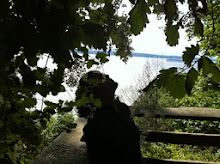However, the path to hell is often paved with good intentions so a word of caution. While a bird feeder can range from a dining plate to a hanging coconut shell, be aware that a dirty bird feeder is a breeding ground for disease. Clean the feeder as often as you clean your teeth– at least once a week. Also while DIY feeders are a celebration of human ingenuity, it is high time that we stop using (let alone reusing) a plastic water bottle and calling it eco-friendly. There is nothing "green" or sustainable about that.
Don't treat birds as a dustbin to discard stale and rotting food. Just like excess of bread and other processed foods like biscuits and chips aren't good for human consumption, similarly they aren't suitable for birds. During breeding season they can prove to be disastrous to the survival of chicks. Buy a bird guide. Get to know your future guests. Find out what they like to eat. Learn their names. Be considerate. Be polite.
The complete photo album is here. The bird feeders in the accompanying photographs are from Kew Gardens.




















No comments:
Post a Comment